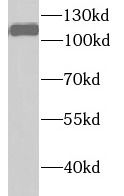Products
UHRF1 antibody
Category:
Research Area:
| Synonyms: | FLJ21925 antibody, hNP95 antibody, HuNp95 antibody, ICBP90 antibody, Nuclear protein 95 antibody, RING finger protein 106 antibody, RNF106 antibody, Transcription factor ICBP90 antibody, UHRF1 antibody | ||
| Catalogue No.: | FNab09245 | Reactivity: | Human |
| Host: | Rabbit | Tested Application: | ELISA, WB, IHC, IF |
| Clonality: | polyclonal | Isotype: | IgG |
- SPECIFICATIONS
- Product Name
- UHRF1 antibody
- Catalogue No.
- FNab09245
- Size
- 100μg
- Form
- liquid
- Purification
- Immunogen affinity purified
- Purity
- ≥95% as determined by SDS-PAGE
- Clonality
- polyclonal
- Isotype
- IgG
- Storage
- PBS with 0.02% sodium azide and 50% glycerol pH 7.3, -20℃ for 12 months (Avoid repeated freeze / thaw cycles.)
Immunogen
- Immunogen
- ubiquitin-like with PHD and ring finger domains 1
- Alternative Names
- FLJ21925 antibody, hNP95 antibody, HuNp95 antibody, ICBP90 antibody, Nuclear protein 95 antibody, RING finger protein 106 antibody, RNF106 antibody, Transcription factor ICBP90 antibody, UHRF1 antibody
- UniProt ID
- Q96T88
- Observed MW
- 110 kDa
Application
- Tested Applications
- ELISA, WB, IHC, IF
- Recommended dilution
- WB: 1:500 - 1:2000; IHC: 1:50 - 1:200; IF: 1:20 - 1:50
Validated Images
 HeLa cells were subjected to SDS PAGE followed by western blot with FNab09245(UHRF1 antibody) at dilution of 1:1000
HeLa cells were subjected to SDS PAGE followed by western blot with FNab09245(UHRF1 antibody) at dilution of 1:1000
 Immunohistochemistry of paraffin-embedded human lung cancer using FNab09245(UHRF1 antibody) at dilution of 1:100
Immunohistochemistry of paraffin-embedded human lung cancer using FNab09245(UHRF1 antibody) at dilution of 1:100
- Background
- This gene encodes a member of a subfamily of RING-finger type E3 ubiquitin ligases. The protein binds to specific DNA sequences, and recruits a histone deacetylase to regulate gene expression. Its expression peaks at late G1 phase and continues during G2 and M phases of the cell cycle. It plays a major role in the G1/S transition by regulating topoisomerase IIalpha and retinoblastoma gene expression, and functions in the p53-dependent DNA damage checkpoint. It is regarded as a hub protein for the integration of epigenetic information. This gene is up-regulated in various cancers, and it is therefore considered to be a therapeutic target. Multiple transcript variants encoding different isoforms have been found for this gene. A related pseudogene exists on chromosome 12.



